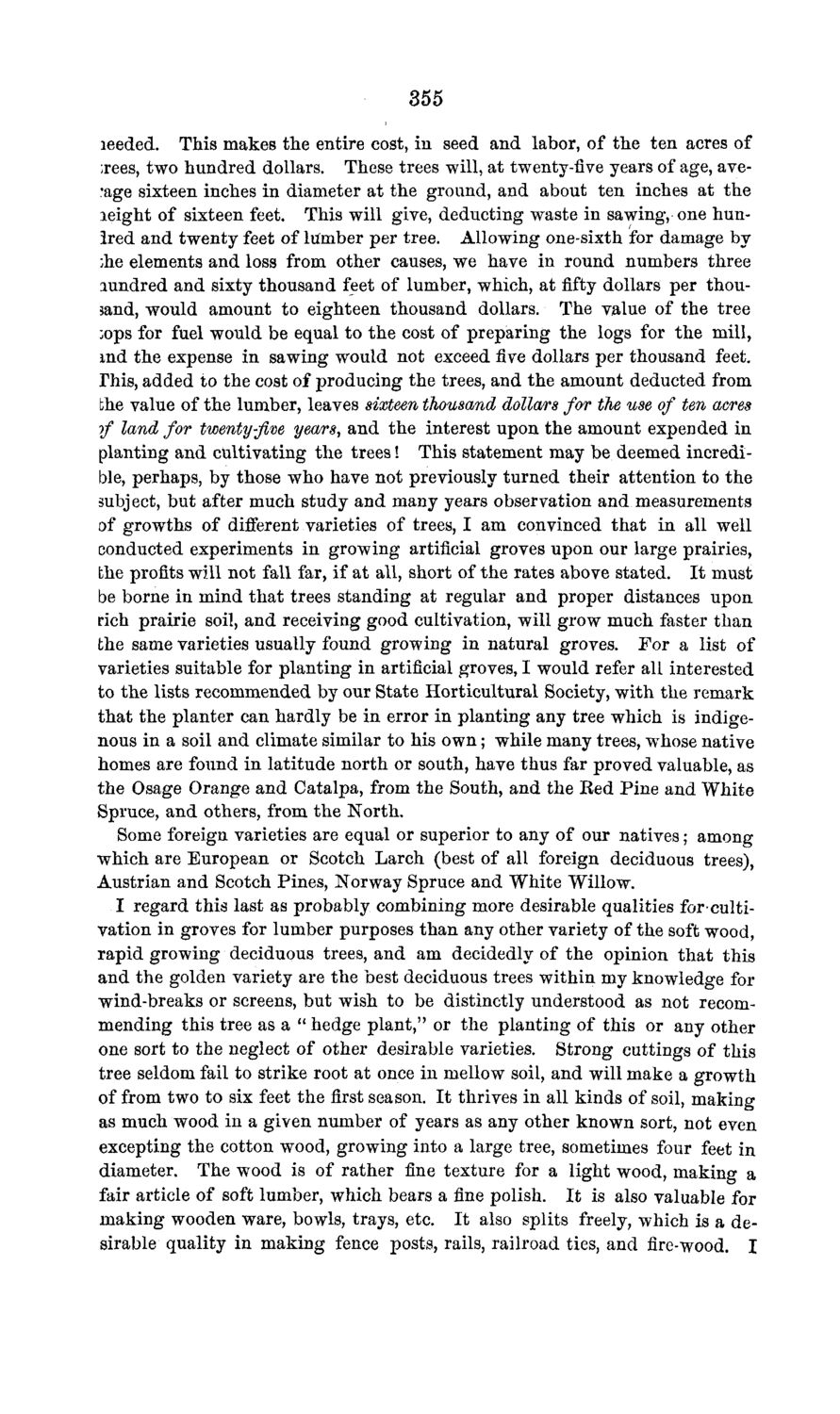| |
| |
Caption: Board of Trustees Minutes - 1869
This is a reduced-resolution page image for fast online browsing.

EXTRACTED TEXT FROM PAGE:
355 leeded. This makes the entire cost, in seed and labor, of the ten acres of ;rees, two hundred dollars. These trees will, at twenty-five years of age, average sixteen inches in diameter at the ground, and about ten inches at the leight of sixteen feet. This will give, deducting waste in sawing, one hunIred and twenty feet of lumber per tree. Allowing one-sixth for damage by :he elements and loss from other causes, we have in round numbers three hundred and sixty thousand feet of lumber, which, at fifty dollars per thousand, would amount to eighteen thousand dollars. The value of the tree ;ops for fuel would be equal to the cost of preparing the logs for the mill, ind the expense in sawing would not exceed five dollars per thousand feet. This, added to the cost of producing the trees, and the amount deducted from the value of the lumber, leaves sixteen thousand dollars for the use of ten acres if land for twenty-five years, and the interest upon the amount expended in planting and cultivating the trees! This statement may be deemed incredible, perhaps, by those who have not previously turned their attention to the subject, but after much study and many years observation and measurements of growths of different varieties of trees, I am convinced that in all well conducted experiments in growing artificial groves upon our large prairies, the profits will not fall far, if at all, short of the rates above stated. It must be borne in mind that trees standing at regular and proper distances upon rich prairie soil, and receiving good cultivation, will grow much faster than the same varieties usually found growing in natural groves. For a list of varieties suitable for planting in artificial groves, I would refer all interested to the lists recommended by our State Horticultural Society, with the remark that the planter can hardly be in error in planting any tree which is indigenous in a soil and climate similar to his own; while many trees, w^hose native homes are found in latitude north or south, have thus far proved valuable, as the Osage Orange and Catalpa, from the South, and the Red Pine and White Spruce, and others, from the North. Some foreign varieties are equal or superior to any of our natives; among which are European or Scotch Larch (best of all foreign deciduous trees), Austrian and Scotch Pines, Norway Spruce and White Willow. I regard this last as probably combining more desirable qualities for*cultivation in groves for lumber purposes than any other variety of the soft wood, rapid growing deciduous trees, and am decidedly of the opinion that this and the golden variety are the best deciduous trees within my knowledge for wind-breaks or screens, but wish to be distinctly understood as not recommending this tree as a " hedge plant," or the planting of this or any other one sort to the neglect of other desirable varieties. Strong cuttings of this tree seldom fail to strike root at once in mellow soil, and will make a growth of from two to six feet the first season. It thrives in all kinds of soil, making as much wood in a given number of years as any other known sort, not even excepting the cotton wood, growing into a large tree, sometimes four feet in diameter. The wood is of rather fine texture for a light wood, making a fair article of soft lumber, which bears a fine polish. It is also valuable for making wooden ware, bowls, trays, etc. It also splits freely, which is a desirable quality in making fence posts, rails, railroad ties, and fire-wood. I
| |